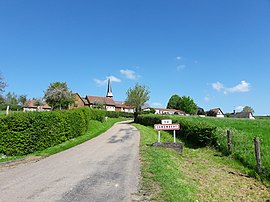Camembert, Orne
Camembert | |
|---|---|
 The road into Camembert | |
show Location of Camembert | |
 Camembert | |
| Coordinates: 48°53′38″N 0°10′42″E / 48.8938°N 0.1783°ECoordinates: 48°53′38″N 0°10′42″E / 48.8938°N 0.1783°E | |
| Country | France |
| Region | Normandy |
| Department | Orne |
| Arrondissement | Mortagne-au-Perche |
| Canton | Vimoutiers |
| Area 1 | 10.3 km2 (4.0 sq mi) |
| Population (Jan. 2018)[1] | 182 |
| • Density | 18/km2 (46/sq mi) |
| Time zone | UTC+01:00 (CET) |
| • Summer (DST) | UTC+02:00 (CEST) |
| INSEE/Postal code | 61071 /61120 |
| Elevation | 111–237 m (364–778 ft) (avg. 137 m or 449 ft) |
| 1 French Land Register data, which excludes lakes, ponds, glaciers > 1 km2 (0.386 sq mi or 247 acres) and river estuaries. | |
Camembert (French pronunciation: [kamɑ̃bɛʁ] (![]() listen)) is a commune in the Orne department in north-western France.
listen)) is a commune in the Orne department in north-western France.
It is the place where camembert cheese originated.
Camembert has been called "The largest small village in France." This is because the area of the commune itself is out of proportion to the center of the village which consists of the Cheese Museum (in the shape of a Camembert cheese), the Town Hall (Mairie), the Church of St Anne, the Ferme Président (a museum), Beamoncel (the house where Marie Harel, the creator of camembert cheese lived) and 3 other small houses. The rest of the commune is scattered over 10 km2 (2,500 acres).
History[]
The village is most noted for the early development of camembert cheese by Marie Harel in 1791.
Population[]
| Year | Pop. | ±% |
|---|---|---|
| 1999 | 197 | — |
| 2012 | 196 | −0.5% |
See also[]
- Communes of the Orne department
References[]
- ^ "Populations légales 2018". INSEE. 28 December 2020.
External links[]
| Wikimedia Commons has media related to Camembert. |
Categories:
- Communes of Orne
- Orne geography stubs


